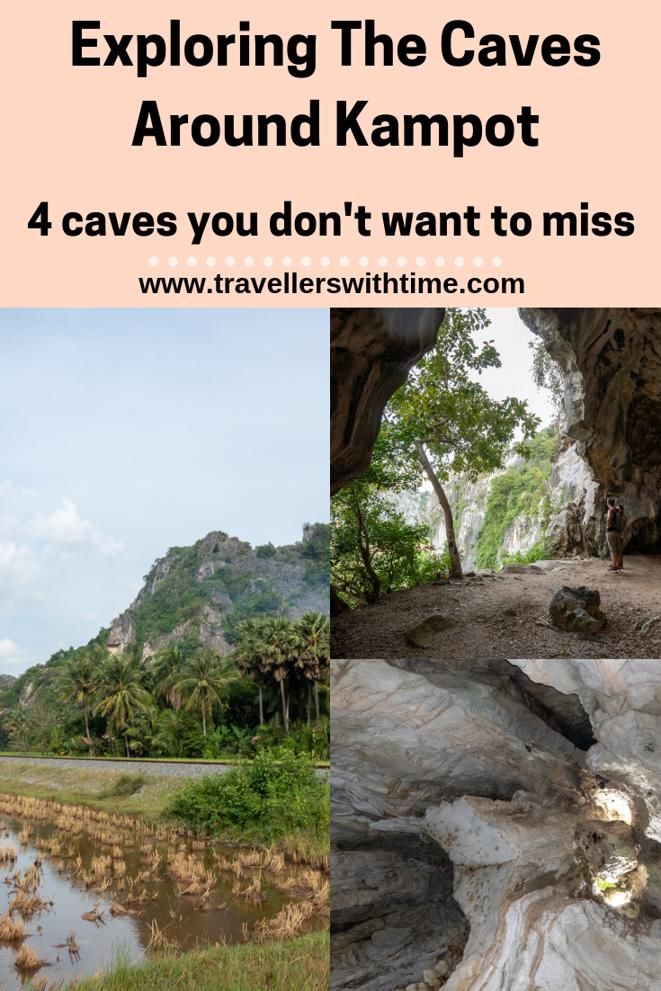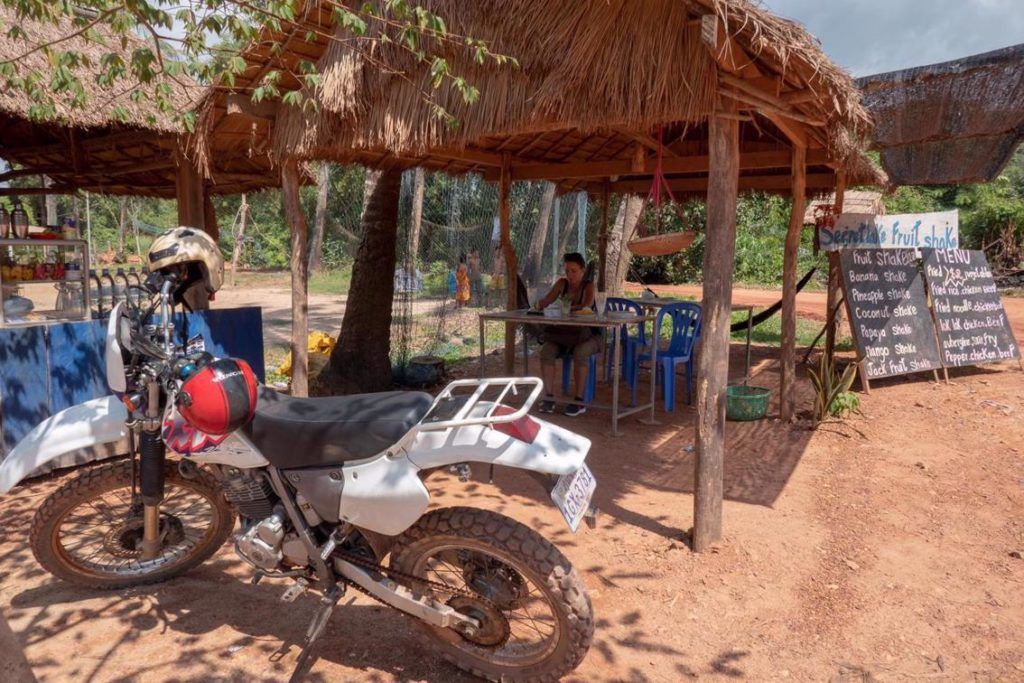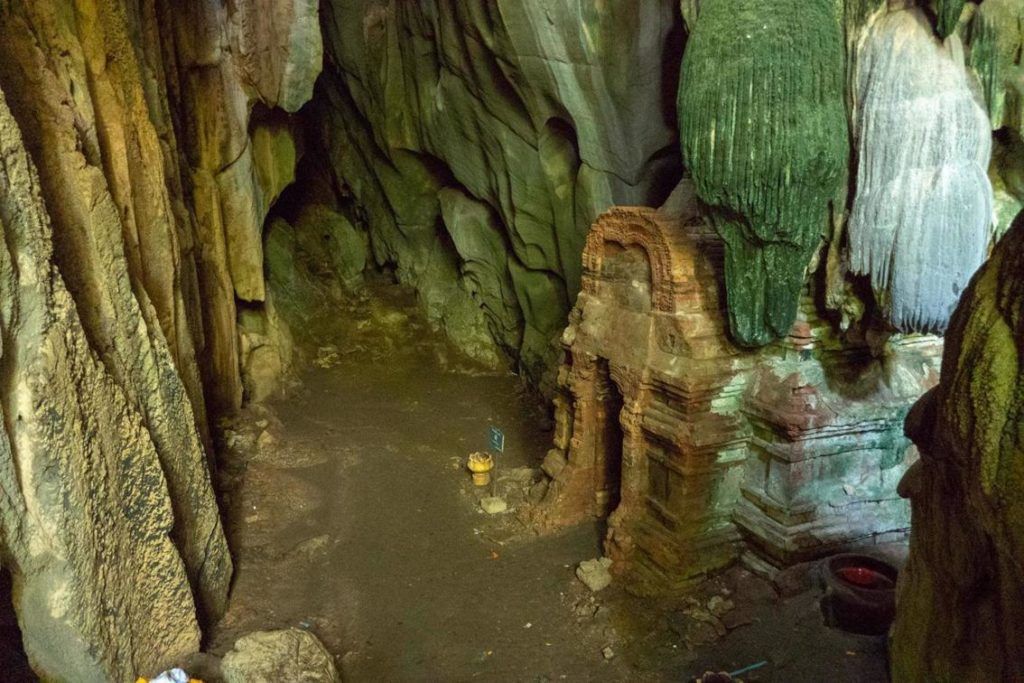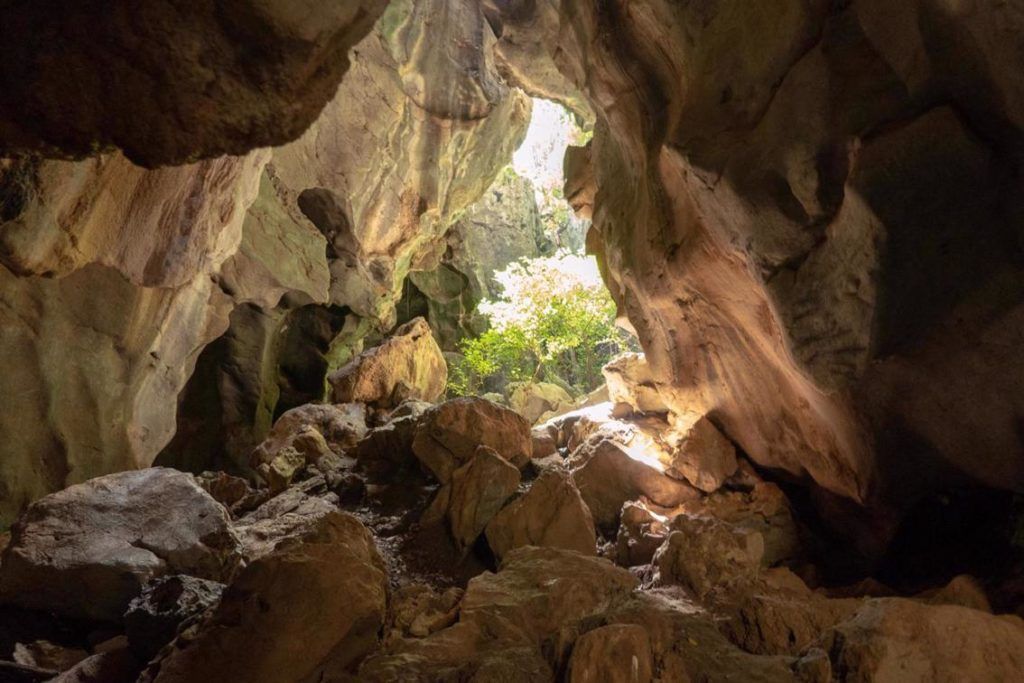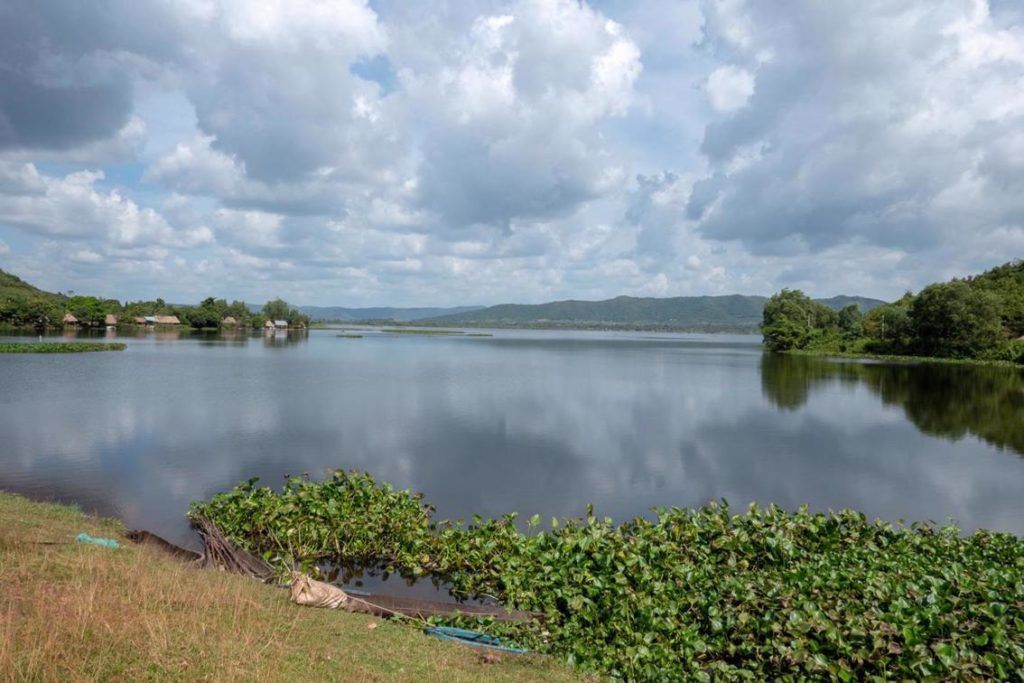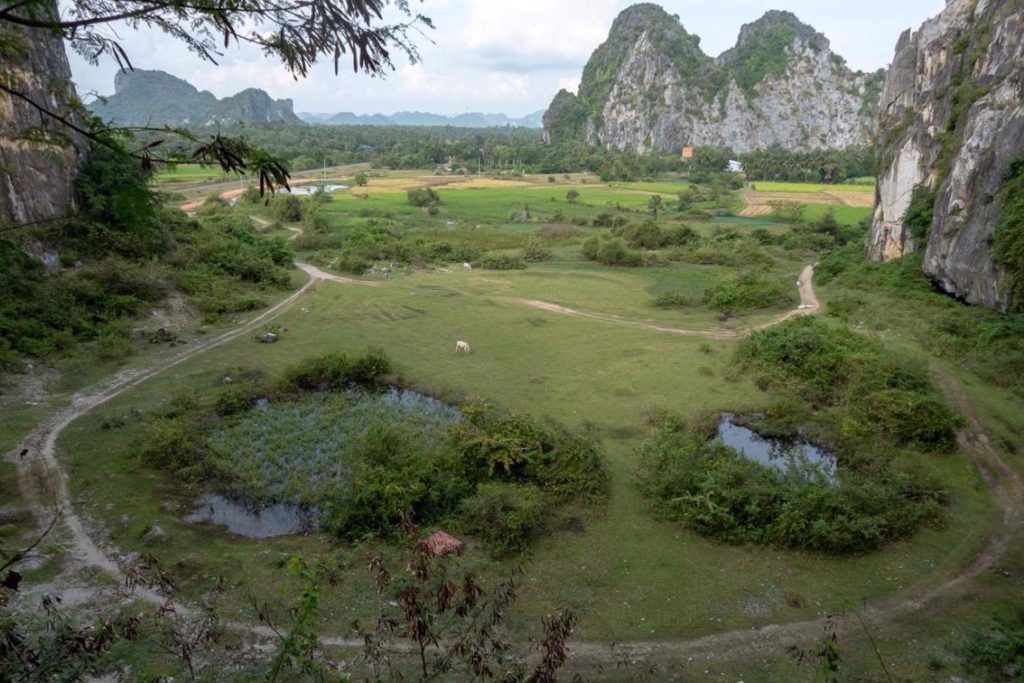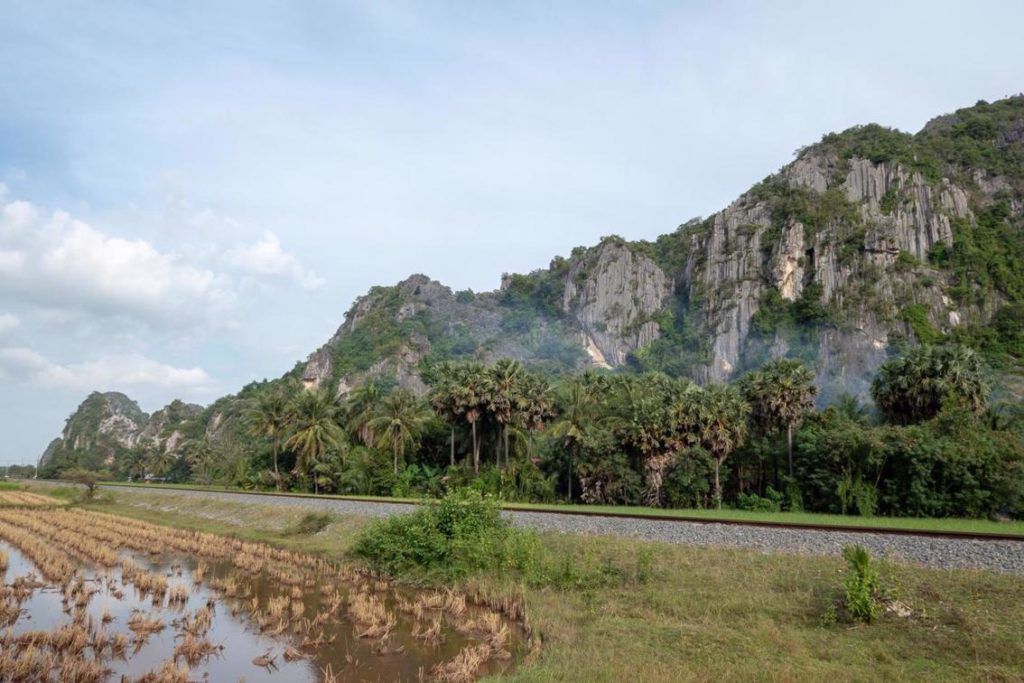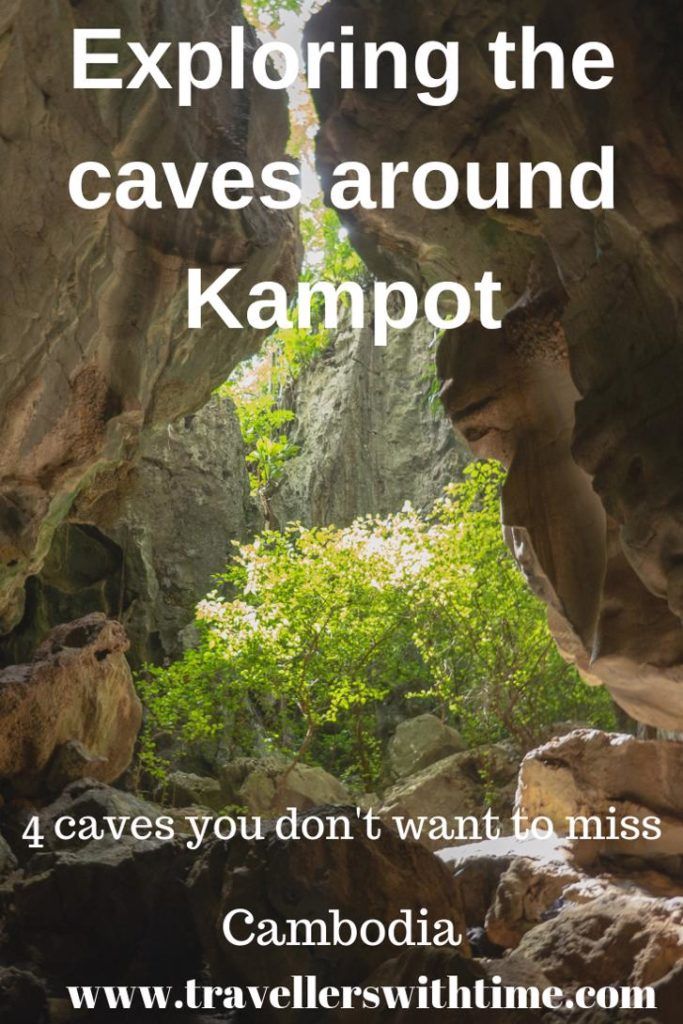Kampot Caves
Located a short distance outside Kampot town are a series of limestone karst mountains that hide numerous caves and caverns. The Kampot caves have an interesting history, both being used as religious shrines, and also to harbour locals during tumultuous times, such as when the Khmer Rouge were in power.
Hiring a motorbike to explore the caves
Hiring a motorbike or scooter is an easy way to get around, if you know how to ride. We always like to DIY our trips, and this time was no exception. Motorbike hire from Kampot will cost you upwards of $4 USD for the day. $4 will get you a small scooter.
If you follow our blog you’ll know that we usually prefer a bigger bike when there is any kind of hills involved so we hired a large dirt bike for $20 USD.
We were thankful we did! The roads to many of the caves are riveted, potholed dirt tracks. You can absolutely get around with a scooter, the locals do, but after riding all day we were glad for the suspension and bigger tires!
Phnom Chhork and Kbal Romeas
If you’re riding in from Kampot, these two sites are not that far from one another. At a Y intersection you’ll go left to Phnom Chhork and right to Kbal Romeas.
Phnom Chhnork cave Kampot
Phnom Chhnork cave is located about 8km from Kampot and is the most often visited cave.
If you’re on a motorbike, be prepared for a very bumpy ride as the dirt road that leads towards the cave is in poor condition. As you pull off the ‘main’ dirt track, you’ll see a hand written sign saying ‘the easy way to Phnom Chhnork cave’. This is locals code for ‘come this way and we’ll charge you for parking’. If you drive about 2 meters ahead and go up the other side of the river you can park for free in front of the cave.
Which ever road you take, you’ll be met with the offer of a guide. The men will ignore you once you say no, but unfortunately the cute little girls will follow you and expect to be paid for their guidance. If you’ve been in Cambodia any length of time, you’ve seen this before. According to every organisation the best thing to do is to not accept their services and therefore to NOT pay them. Be firm with your ‘no’ because they’ll follow you.
The first thing you’ll come across is a small cave, with a ladder that goes up and into the cave above. You can enter if you want but it may be best to pay one of the older male guides here, not one of the kids. Otherwise, if you walk further up to your right, you’ll see a huge staircase that goes up to the Phnom Chhnork Cave temple.
Phnom Chhnork cave temple
If you make your way up the 200 or so stairs and then descend into the Phnom Chhnork cave temple, you’ll be standing next to a Hindu Shrine that was constructed in the 7th century. The condition of the shrine is magnificent, thanks to the protection of the cave. The temple is dedicated to Shiva. If you look inside the temple you’ll see an ancient stalactite ‘lingam’.
There are some lovely stalactites and stalagmites within the cave. You can apparently also climb down through the cave (the same way you could have come up), but you’ll probably need a guide to point out the entry point as it isn’t the place you think it is!
Phnom Chnnork Cave map
Kbal Romeas
You’ll find the cave only a short distance past the Kbal Romeas Prehistoric Site sign. The most obvious thing will be the large Climbodia sign. The entrance for the cave is $1 USD that you pay to a man that lives in a house at the start of the street….
Kbal Romeas is known for sheltering Khmer, Cham and Chinese people during the time of the Khmer Rouge.
A wooden bridge takes you across to enter the cave and the size of the main cavern is amazing. The cave has quite a bit of natural light, although a flashlight, or even that from your phone should pave the way in the darkest places.
The only other people we saw at Kbal Romeas were the Climboda people and some climbers, so we explored the inside of the cave on our own. It’s beautiful and worth the visit.
The Secret Lake Kampot
The Secret lake is a beautiful large lake located in rural Cambodia near La Plantation, Kampots famous pepper plantation. It really is a beautiful spot. There are some restuarants and bamboo seating areas surrounding the lake. You can also take a big pelican paddle boat out on the the lake if you choose to.
Secret Lake Kampot History
Known locally as Tomnop Tek Krolar, the secret lake really isn’t a secret. It’s visible from quite a few vantage points in the area and is perfectly located between the mountains, pepper plantations and rice paddies. The beauty of the secret lake however belies it’s history.
Constructed with forced labour during the Khmer Rouge period, the dam and lake apparently hide the bodies of the many people who died during it’s construction.
Secret Lake Kampot: Swimming?
Apparently you’re able to swim in the lake and I have no doubt locals probably do. Whether we would want to or not, I don’t know. There’s some talk about the lake not being particularly healthy.
Secret Lake Kampot map
Phnom Sorsia
We got quite lost on the magnificent rural back roads to Phnom Sorsia. Driving through the beautiful agricultural area, Google Maps said it should have been right in front of us….except there was no mountain anywhere near us… and even if there was, the flowing river stopped us from moving forward!
Phnom Sorsia is apparently known for its rock formations and beautiful views. Let us know if you happen to find it!
Kampong Trach Cave
Kampong Trach cave is located roughly an hour or so from Kampot if you use the main roads. We took a lot longer to reach it after dirt biking our way through the stunning rural countryside. I can’t really think of a better way to get lost… You can also visit Kampong Trach cave quite easily from Kep.
What strikes you as you approach Kampong Trach is the beautiful limestone face of the mountain and the blue water at its base. These limestone karst mountains are ancient, and although common in Vietnam in places like Phong Nha and Trang An, they’re less common here. The blue water is caused by the limestone that dissolves into the water below.
Swimming cave in Kampot
When you first arrive you’ll see a ground level under water cave and river to your left. The locals will tell you it is the swimming cave in Kampot. If you’re game enough to get in the water it would be a great experience to explore underneath. We weren’t prepared for swimming, and although the water looked ‘fine’, I’m not sure I would be going in.
Kampong Trach cave temple
Up to the right you’ll see a shrine at ground level and some stairs leading up the side of the mountain. You will also find someone here willing to guide you for a small fee. The lady waving us up the stairs seemed like she needed a dollar more than we did so we followed her and allowed her to explain the elephant rock formations and point out things like bats within the cave.
The views are stunning, and although the shrine inside the cave isn’t spectacular, it is worth the climb.
Tips for visiting the Kampot Caves
Good shoes are a must for visiting the Kampot Caves, especially Phnom Chhnork and apparently Phnom Sorsia. You’ll need to do a bit of clambering to properly explore and some of the rocks are wet and slippery. A torch, headlight or phone light is also needed in some areas of the caves.
We’d also recommend you take a few bottles of water as it’s quite humid inside some of the caves and you’ll end up sweating quite a bit.
If you’re out exploring on the motorbike for the day, a helmet should be a given, but unfortunately it’s not. Sunscreen, water and good shoes are a good idea.
You may also find these posts useful
- Exploring Bokor National Park Kampot
- Hiking in Kep National Park
Like it? Pin it?
